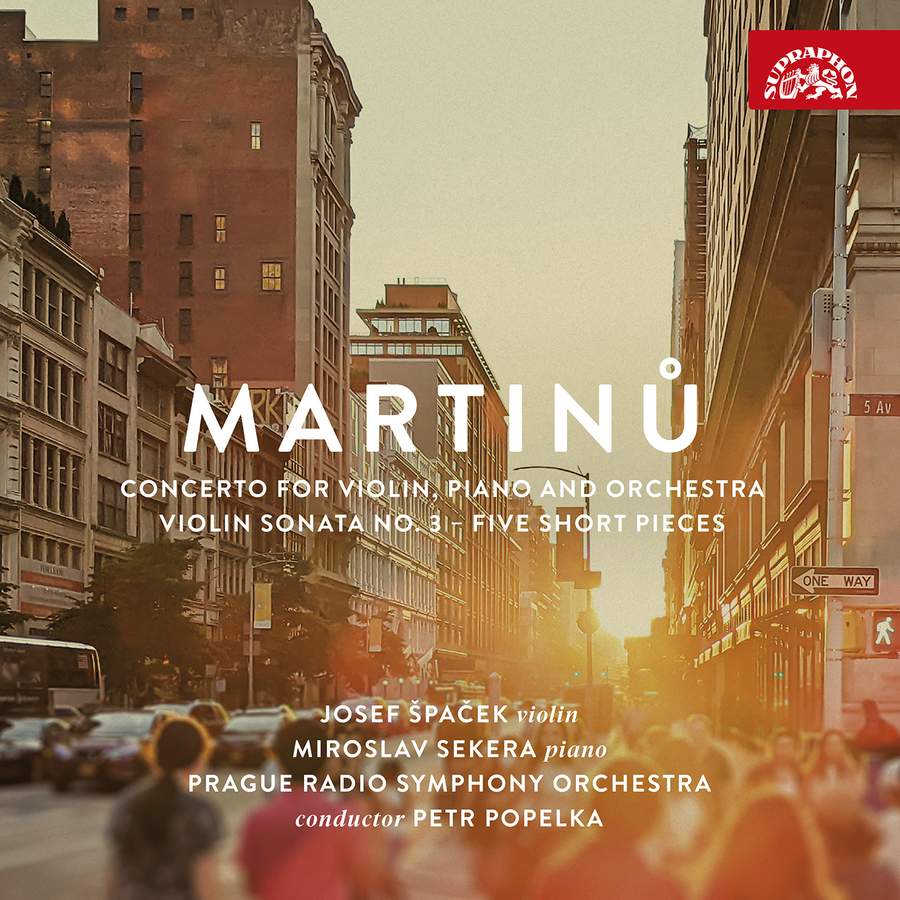MARTINŮ Concerto for Violin, Piano and Orchestra (Josef Špaček, Miroslav Sekera)
View record and artist detailsRecord and Artist Details
Genre:
Orchestral
Label: Supraphon
Magazine Review Date: AW23
Media Format: CD or Download
Media Runtime: 63
Mastering:
DDD
Catalogue Number: SU4330-2

Tracks:
| Composition | Artist Credit |
|---|---|
| Concerto for Violin, Piano and Orchestra |
Bohuslav (Jan) Martinu, Composer
Josef Špaček, Violin Miroslav Sekera, Piano Petr Popelka, Conductor Prague Radio Symphony Orchestra |
| Sonata for Violin and Piano No. 3 |
Bohuslav (Jan) Martinu, Composer
Josef Špaček, Violin Miroslav Sekera, Piano |
| (5) Short Pieces |
Bohuslav (Jan) Martinu, Composer
Josef Špaček, Violin Miroslav Sekera, Piano |
Author: David Gutman
Martinů’s eccentric compositional fluency can throw even ardent admirers off the scent. Of the three works included in the present collection, only the Third Violin Sonata (1944) is generally well regarded. In Martinů and the Symphony (Toccata Press: 2010), Michael Crump goes so far as to condemn the Concerto for violin, piano and orchestra (1953) as ‘a hum-drum, unexceptional work which could have been written at any time during the previous dozen or more years’.
A performance as tight and ardent as this new one suggests that a rethink is in order. The music might indeed be said to look back, its melodies and cadences radiating homespun charm, its first movement busily neo-Baroque. At the same time there are premonitions of Philip Glass and surrealistic zones of rapture, alighted upon as if by mere chance. The real difficulty may be one of balance. A composer partial to including the piano in his orchestral writing presumably wanted something different here. Previous recordings made in a wetter acoustic have had to focus on rescuing the violin from the prevailing melee, treating the piano as a continuo instrument. This one, better balanced in the main, is licensed in from Czech Radio. However sympathetically accompanied and miked (helpfully the soloists tend to alternate their purple passages in the unstable, deceptively simple central movement), the work is never going to be easy to play or to programme. The finale takes us back to C major, its dream-logic elusive. Even Josef Špaček, driving forwards with irresistible joie de vivre and fullness of tone, can sound hard-pressed.
On paper Špaček’s tried-and-tested partnership with Miroslav Sekera faces serious competition in the Sonata, although the Czech duo benefit from more modern sound than big-name rivals. A live account from David Oistrakh enjoys a high reputation among fiddle fanciers and executants alike while relegating Frida Bauer’s piano to the middle distance (Brilliant Classics, 6/07). Josef Suk and Josef Hála, arguably more idiomatic than the Soviet pair if less intense (Supraphon, 8/90), are outclassed now by Špaček and Sekera. The newcomers find room for a real rarity in the Five Short Pieces (1930). I have seen these described as unduly dry and uncharacteristic of the composer. Yet if other voices are present – Prokofiev’s Five Melodies, Op 35b, would have been new music at the time – so too is the composer’s own. Martinů found his feet compositionally and emotionally not in Prague but in the Paris of the 1920s so expect traces of both Hindemith and the vernacular Americana that was all the rage. As Jaroslav Mihule’s helpful notes suggest, what’s missing is the nostalgia and pain of the émigré experience.
All told, a fascinating, unpredictable listen.
Explore the world’s largest classical music catalogue on Apple Music Classical.
Included with an Apple Music subscription. Download now.

Gramophone Digital Club
- Digital Edition
- Digital Archive
- Reviews Database
- Events & Offers
From £9.20 / month
Subscribe
Gramophone Club
- Print Edition
- Digital Edition
- Digital Archive
- Reviews Database
- Events & Offers
From £11.45 / month
Subscribe
If you are a library, university or other organisation that would be interested in an institutional subscription to Gramophone please click here for further information.






